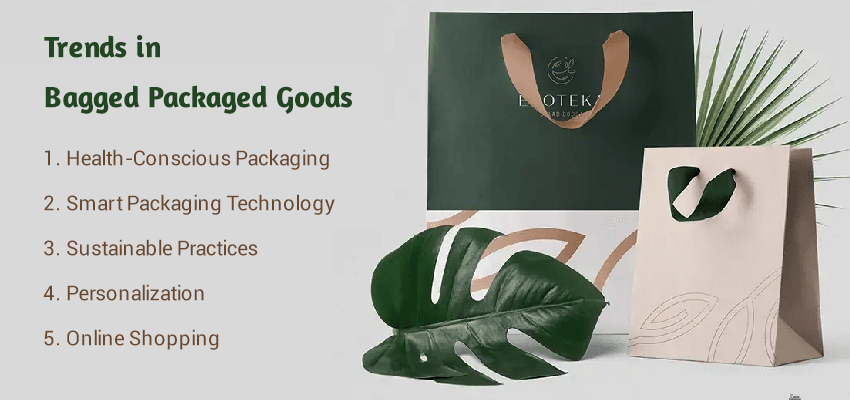
In today’s fast-paced world, convenience is the key. One of the most popular forms of packaging that caters to this demand is bagged packaged goods.
Whether it’s snacks, pet food, or household products, bagged goods offer practicality and ease of use.
In this article, we’ll explore the different types of bagged packaged goods, their benefits, and emerging trends, and answer some frequently asked questions.
What Are Bagged Packaged Goods?
Bagged packaged goods refer to products that are sold in bags made from various materials, such as plastic, paper, or biodegradable substances.
This type of retail packaging is widely used across different industries due to its flexibility, cost-effectiveness, and user-friendliness.
Types of Bagged Packaged Goods

These are discussed below:
1. Snack Foods
One of the most common examples of bagged goods is snack foods like chips, popcorn, and nuts, which are often packaged in resealable bags. This helps to maintain freshness and allows easy snacking on the go.
2. Pet Food
Pet owners appreciate the convenience of bagged pet food. These bags are designed to be durable and often feature resealable openings to keep the food fresh. They come in several sizes to accommodate different pets’ needs.
3. Grains and Cereals
Many grains, rice, and cereals are packaged in bags that offer protection from moisture and pests. These bags are often designed for easy pouring and storage purposes.
4. Household Products
Items like soil, fertilizer, and cleaning supplies are frequently found in bagged form. This kind of eco-friendly packaging makes it very easy to transport and store these products.
5. Frozen Foods
While many frozen items come in boxes, bagged options are becoming increasingly popular. Bagged frozen vegetables and fruits are easy to portion and store. It helps to reduce the waste.
Benefits of Bagged Packaged Goods
Bagged packaged goods offer numerous advantages that make them appealing to both consumers and manufacturers:
1. Convenience
The main benefit of bagged goods is their ease of use. They are lightweight, portable, and often resealable. This makes them perfect for the on-the-go lifestyle.
2. Cost-Effectiveness
Producing bagged packaging is usually more economical than boxed packaged goods. This leads to lower prices for the consumers while still providing quality products.
3. Sustainability
Many manufacturers are now using eco-friendly materials for bagged goods. Biodegradable and recyclable bags are gaining popularity as consumers become more environmentally conscious.
4. Freshness Preservation
Resealable bags help to maintain products’ freshness for longer periods. This feature is especially important for food items, as it minimizes waste and maximizes enjoyment.
5. Customizable Designs
Bagged packaging offers several creative designs and branding opportunities. Companies can easily modify sizes, colors, and labels to appeal to different target markets.
Trends in Bagged Packaged Goods

The bagged goods market is evolving, driven by consumers’ preferences and technological advancements. Here are some notable trends:
1. Health-Conscious Packaging
As consumers become more health-conscious, there is a rising demand for nutritious bagged goods. Brands are focusing on healthy snacks, organic pet food, and whole grain options.
2. Smart Packaging Technology
Innovations like QR codes and augmented reality are making their way into bagged packaging. These technologies allow consumers to access information about product sourcing, nutritional values, and usage tips.
3. Sustainable Practices
With the growing emphasis on sustainability, many companies are switching to biodegradable or compostable bagged packaging. This trend aligns with consumer desires for eco-friendly products.
4. Personalization
Customization is becoming more common in the bagged goods market. Brands are offering personalized packaging options to enhance consumer connection and brand loyalty.
5. Online Shopping
The rise of e-commerce has increased the demand for bagged packaged goods. Consumers appreciate the convenience of ordering their favorite snacks and products online.
FAQs About Bagged Packaged Goods
Some of the most common FAQs about Bagged Packaged Goods are discussed below:
1. What are the most common materials used for bagged packaged goods?
Common materials include plastic (polyethylene and polypropylene), paper, and biodegradable options. Each material has its benefits, such as durability or eco-friendliness.
2. How do bagged goods help reduce food waste?
Resealable bags maintain product freshness longer, allowing consumers to use only what they need and store the rest safely. This reduces spoilage and waste generation.
3. Are bagged packaged goods recyclable?
Many bagged packaged goods are recyclable, but it depends on the material. Check local recycling guidelines to see which types are accepted.
4. How can consumers ensure they are choosing sustainable bagged goods?
Look for certifications such as "biodegradable," "compostable," or "recyclable." Additionally, brands that focus on sustainability often provide information on their packaging practices.
5. What innovations are expected in the bagged goods market?
Expect to see more smart packaging technologies, such as temperature indicators and QR codes, as well as an increased emphasis on sustainable materials and personalized packaging options.
Wrapping Up:
Bagged packaged goods are a versatile and practical solution for modern consumers. With their convenience and sustainability features, they are becoming an essential part of our daily lives.
As the market continues to evolve, manufacturers must adapt according to the trends and consumer preferences to survive.
At Your Box Packaging, we understand the importance of quality packaging solutions. Our innovative bagged packaging options are designed to meet the needs of various industries.
Partner with us to elevate your brand with effective and sustainable bagged packaged goods. Contact us via email at sales@yourboxpackaging.com to outshine your peers with our assistance and become the leading brand in your industry.


